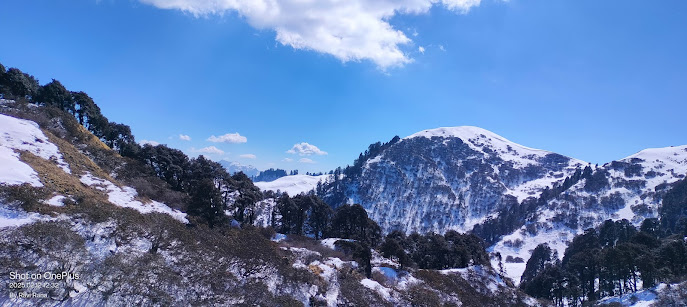 |
| Surya Top Peak |
1. Summer (Late April to June) – Green Meadows & Clear Skies
Summer is when Surya Top comes to life. The meadows are at their greenest, stretching for miles under the warm sun. The wildflowers cover the valley, adding bursts of color to the landscape. The air is crisp in the morning, turning pleasantly warm by midday.
Surya Top Trek Difficulty: Moderate – great for beginners and experienced trekkers.
Snow: Minimal, mostly in shaded areas during early May.
Surya Top Trek Temperature: 18–24°C (day), 3–4°C (night).
Surya Top Trek Highlights: Clear, though a light summer haze may soften the mountain outlines.
Why You Should Trek in Summer?
Comfortable temperatures: The pleasant temperatures of summer make trekking a comfortable and enjoyable experience, allowing you to walk with ease through the high-altitude trails.
Surreal Grasslands: The meadows of Surya Top come alive, stretching endlessly in lush green waves and dotted with vibrant wildflowers that paint the landscape in bursts of red, yellow, and violet. Making it a paradise for photographers and nature lovers.
Stable weather: With crystal clear skies and stable weather, the journey feels smooth and predictable, free from sudden downpours or snow-blocked paths.
If you’re looking for a scenic, refreshing trek through the heart of the Himalayas, the summer season is the best time to visit Surya Top trek in 2025.
2. Post-Monsoon (September to Early December) – Golden Landscapes & Crystal-Clear Views
As the monsoon rains fade, the Himalayas sharpen. The skies are deep blue, and the distant peaks stand clear and crisp. The meadows, once green, turn into golden fields stretching toward the horizon.
Surya Top Trek Difficulty Level: Moderate – slightly colder nights than summer.
Snow: No snow in September or October. Light frost and occasional snowfall by late November.
Surya Top Temperature: 15–20°C (day), 0 to -2°C (night).
Scenic Views: This trek offers one of the best landscapes, crystal-clear mountain peaks, sharp ridgelines, and endless horizons.
Why You Should Trek Surya Top in Post-Monsoon?
The autumn season transforms the entire region into a serene expanse of golden meadows, fresh mountain air, and crystal-clear skies, where every ridge and valley glows under the soft, amber light of the setting sun.
Overall, this is the ultimate season for photographers, mountain lovers, and adventurers. If you crave unparalleled visibility and breathtaking panoramas, this season is then best time to explore Surya Top Trek in 2025.
3. Winter (Mid-December to February) – Harsh Conditions & Deep Snow
Unlike the Kedarkantha and Har ki Dun Treks which are one of the best winter treks in Uttarakhand, the Surya Top trek remains inaccessible. Heavy snow covers the meadows, and temperatures drop well below freezing. The trek becomes harsh, unpredictable, and dangerous for trekkers.
Surya Top Trek Difficulty: Very difficult and requires advanced trekking experience.
Snow: High levels of snowfall block trails.
Temperature: 0–10°C (day), -5 to -10°C (night).
Views: Clear but often blocked by snowstorms and cloud cover.
Why Trekkers Should Avoid Surya Top In Winter?
Winter at Surya Top buries the trails in deep snow, making trekking dangerous and nearly impossible. The bitter cold demands specialized gear, and sudden snowstorms can wipe out visibility, leaving trekkers stranded.
With such unpredictable weather and extreme trekking conditions, even experienced adventurers face serious risks. If you do not have technical mountaineering skills then this season is best to avoid trekking in winter. For a safer, more rewarding trek, wait for the warmer months when the trails are open and the mountains welcome you with clear skies.
4. Early Spring (February to March) – Snowy Trails & Unpredictable Weather
Spring at Surya Top is a mix of lingering winter and the first signs of change. The lower trails begin to clear, but snow still clings to higher altitudes. Trekking is possible, but challenging.
Difficulty Level of Surya Top Trek: Difficult – snow-covered trails require caution.
Snow: High – many shaded areas remain covered.
Temperature: 5–15°C (day), -2 to -5°C (night).
Views: Mostly clear, but the snow makes trekking tough.
Why Early Spring Season Is Not Recommended?
Spring at Surya Top is unpredictable and challenging. Snow still covers parts of the trail, making navigation difficult. Also, nights are biting cold, and if you are not well prepared with proper trekking gear then staying warm would be tough.
Also, sudden changes in weather and unexpected snowfall block paths. The mix of melting and lingering snow creates slippery, uneven terrain.
So, if you are seeking a smooth and hassle-free trek then the spring season is not the best time for Surya top trek.
Final Recommendation – Best Time for Surya Top Trek 2025
Planning Your Trek? Keep These Tips in Mind
Here are some important tips that you should consider before starting your unforgettable trekking journey to Surya Top Trek:
Book early: Summer and post-monsoon are peak seasons.
Check the weather forecast: Even the best seasons can have surprises.
Train beforehand: A moderate level of fitness is required.
Carry the right gear: Layers are key, as temperatures vary widely.
To conclude, Surya Top is one of the most breathtaking treks in India, but timing is the most crucial for starting this trek. I hope this article will guide you in choosing the right season for trekking in the Uttarakhand Himalayas.
Comments
Post a Comment